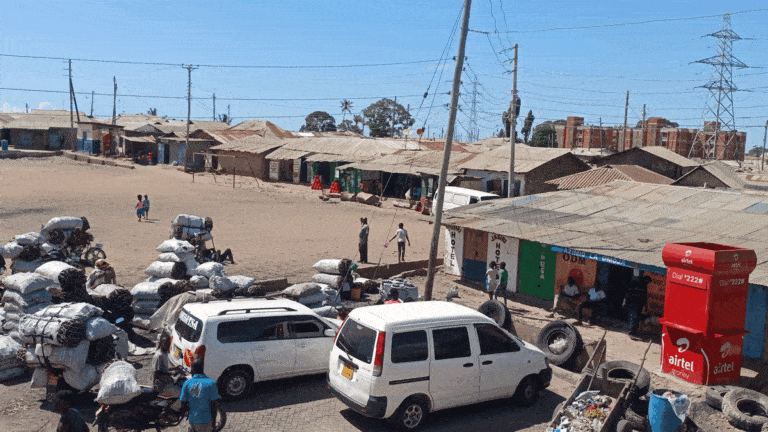In 2017, Kenya’s Standard Gauge Railway (SGR) – a flagship project of China’s Belt and Road Initiative (BRI) – was unveiled as a symbol of national progress. Promising faster cargo transport, reduced costs, and modernity, sleek images of trains slicing across the landscape captured the public imagination.
Yet in Mombasa, to ensure the railway’s profitability, the government quietly enforced policies that forcibly shifted cargo transport from trucks onto trains (Bagwandeen 2023). Almost overnight, thousands of truck drivers, loaders, roadside vendors, and small traders lost their livelihoods. The once-vibrant streets around Mombasa’s iconic sculpture of elephant tusks fell eerily silent, offering a haunting portrait of “progress” as erasure.

Local Reactions
Frustration soon turned into protest. In 2018, traders, truckers, dockworkers, and civil society groups marched through Mombasa’s streets carrying banners that read “Our Jobs Our Right” and “No Road Transport, No SGR.” Their message was unequivocal: modernization had come at a devastating human cost.
Public anger eventually found political expression five years later, when Mombasa overwhelmingly voted for an opposition presidential candidate who ultimately won the national race. The election result underscored a deeper truth: infrastructure projects that marginalize rather than empower local communities can reverberate politically.
The SGR’s impact also extended beyond economics. The railway cut through national parks, disrupting wildlife migration routes and intensifying human–animal conflict. In the Nairobi National Park, lions displaced by construction began wandering into suburban neighbourhoods – a phenomenon conservationists had long predicted but policymakers had largely ignored (Nyumba 2020).

Neighborhoods in the Shadows
In Mombasa’s working-class neighbourhoods like Bangla, Changamwe and Likoni, the social fallout has been devastating. Homes have crumbled, youth unemployment has soared, and insecurity has deepened. The above photograph of Bangla – a landscape of shuttered shops and abandoned homes – captures the profound stillness and despair that infrastructure left in its wake.
And yet, amid institutional retreat, communities have stepped up. A local philanthropist – a cement manufacturer – founded food banks, provided clean water to impoverished communities, and launched mobile clinics. At the Jay Ram Feeding Centre, hundreds of families now queue daily for what is often their only meal. These queues are not merely symbols of need; they embody resilience – communities helping each other to survive in the shadow of abandonment. The Feeding Centre stands as a palimpsest: a fragile layer of care inscribed over a geography of infrastructural neglect. It mediates the tension between humanitarian relief and structural exclusion, offering not just food, but also a semblance of hope. It is, as Achille Mbembe (2001) might suggest, a space of aesthetic survival, where the city’s brokenness is met with dignity, rhythm, and care. Here, a theology of giving is enacted daily – not through scripture, but through the steam of hot rice and the rustle of second-hand plastic bowls.

Precarity, Exhaustion, and Gendered Sacrifice
Women, particularly, have borne the heaviest brunt of the SGR’s social and economic upheaval. Here, I outline a few examples of persons I have encountered during my research in Mombasa between November 2021 and March 2022, August 2023 and October 2023, and during a short visit in February 2024.
Rehema, once a thriving food vendor in Shimanzi, watched her livelihood collapse as the flow of truck drivers, the lifeblood of her business, dried up. Day after day, she struggles to rebuild her life, her small kitchen standing as a quiet testament to resilience in the face of abandonment.
Bahati, from Likoni, used to sell porridge by the bustling Nairobi highway, catering to truck drivers and loaders. With the collapse of road transport, her small business crumbled. In its place, she now brews and sells mnazi (illicit liquor) to survive, a precarious livelihood that exposes her to police harassment and social stigma. Her pivot, from food vending to illicit brewing, mirrors what Simone (2004) calls “people as infrastructure”: informal actors who navigate urban change through improvisation, skill-sharing, and social labour. Yet Bahati’s “hustle” also embodies the structural pressures of what Thieme (2018) identifies as the “hustle economy”, marked by precarity, exhaustion, and gendered sacrifice rather than entrepreneurial freedom.
Frida, in Changamwe, still stands by her shuttered kiosk, haunted by memories of better days. Once filled with chatter and life, her stall is now a ghostly relic of a more hopeful past. Despite her repeated attempts to pivot to new forms of trade, the collapse of local demand has rendered her efforts futile. This pre-SGR ecosystem reveals the workings of urban survival generated through dense, improvisational ties rather than formal systems. These informal infrastructures, grounded in mutual aid, side hustles, and economic choreography, constituted a kind of shadow logistics.
Spiritual Economies
As formal economies disintegrate, informal and spiritual economies have expanded in response. Witchcraft and traditional healing have gained new prominence, particularly among women navigating the volatility of urban life. For many, witchcraft provides both an explanatory framework for misfortune and a tactical means of countering perceived social sabotage.
Roda’s conviction that she was bewitched by rivals reveals a profound urban spiritual sensibility: hardship is not seen as accidental but as socially – and spiritually – produced. Her openness also highlights what Linda van de Kamp (2016) refers to as “spiritual publics” – social spaces where witchcraft discourse circulates freely and mediates everyday anxieties, entangled with invisible forces.
Scholars such as Jean Comaroff and John Comaroff (1999) and Adam Ashforth (2005) have argued that the revival of occult economies in postcolonial Africa must be understood not as a retreat into irrationality but as a rational response to the opacity and violence of neoliberal capitalism. Similarly, Peter Geschiere (1997) in The Modernity of Witchcraft shows how witchcraft thrives in the very spaces where global modernity and neoliberal markets promise mobility and opportunity but deliver exclusion and uncertainty instead. Here, spiritual economies do not oppose modern capitalism; they are its twin shadows, offering alternative explanations and strategies for survival when promises of development falter.
“The Trains Never Stop for Us”
This fragility of life in post-SGR Mombasa resonates with what Veena Das (2007) describes as “life as it is lived in the aftermath of violence”, where injury and abandonment are woven into the texture of daily existence, rather than remaining singular traumatic events. Their words also made me think of Paul Farmer’s (2004) framing of “structural violence”, the slow, invisible injuries inflicted not by bullets or blades, but by economic exclusion, policy neglect, and infrastructural restructuring. The collapse of food-vending economies, the quiet shuttering of kiosks, the shift toward spiritual explanations; these are not random misfortunes but cumulative expressions of structural violence.
The paradoxes of “development” observed in Mombasa echo the broader patterns James Ferguson (1999) described in Expectations of Modernity in Zambia’s Copperbelt, where promises of modernization unravelled into disappointment, and communities adapted through local strategies of endurance and improvisation. Similarly, Achille Mbembe (2001) in On the Postcolony reminds us that infrastructures, far from being neutral instruments of progress, often produce zones of waste, abandonment, and surplus humanity.
What Mombasa’s experience reveals is precisely this: the afterlife of grand infrastructural dreams can be an archipelago of ruins, where ordinary people must learn to survive among the broken promises of modernity. Ultimately, these stories remind us that infrastructure does not merely move goods; it moves, reshapes, and sometimes unravels entire ways of life.
The SGR connected Mombasa to Nairobi more quickly, but it disconnected families from work, youth from opportunity, and neighbourhoods from hope. As one resident lamented: “The trains pass us, but they never stop for us.” The closed factories, shuttered kiosks, and half-stocked markets stand today as ethnographic monuments – silent witnesses to the dreams, relationships, and routines erased by “development.”
The lesson is clear: development should not be measured by the kilometres of track laid, but by the futures it enables, or extinguishes. Mombasa teaches us that real progress listens to those it claims to uplift, building not just infrastructure, but futures worth living. This study, therefore, urges a critical rethinking of “development”, asking not only what has been built, but what has been broken, and how ordinary people, through creativity, endurance, and solidarity, continue to stitch meaning and dignity from the fragments left behind.
References
Ashforth, Adam. Witchcraft, Violence, and Democracy in South Africa. University of Chicago Press, 2005.
Bagwandeen, M. (2023). “Africa’s Railway Renaissance: Continental Aspirations vs. National Realities”. African Studies Quarterly, 22(1), 1-21.
Comaroff, Jean, and John L. Comaroff. “Occult Economies and the Violence of Abstraction: Notes from the South African Postcolony.” American Ethnologist, 1999.
Das, Veena. Life and Words: Violence and the Descent into the Ordinary. University of California Press, 2007.
Farmer, Paul. Pathologies of Power: Health, Human Rights, and the New War on the Poor. University of California Press, 2004.
Ferguson, James. Expectations of Modernity: Myths and Meanings of Urban Life on the Zambian Copperbelt. University of California Press, 1999.
Geschiere, Peter. The Modernity of Witchcraft: Politics and the Occult in Postcolonial Africa. University of Virginia Press, 1997.
Mbembe, Achille. On the Postcolony. University of California Press, 2001.
Nyumba, T.et al (2021). “Assessing the ecological impacts of transportation infrastructure development: A reconnaissance study of the Standard Gauge Railway in Kenya”. PLoS one, 16 (1), e0246248.
Simone, A. People as Infrastructure: Intersecting Fragments in Johannesburg. Public Culture, 2004.
Thieme, Tatiana. “The Hustle Economy: Informality, Uncertainty and the Geographies of Getting by in Urban Kenya.” Environment and Planning D: Society and Space, 2018.
Van de Kamp, Linda. Violent Conversion: Brazilian Pentecostalism and Urban Women in Mozambique. James Currey, 2016.
